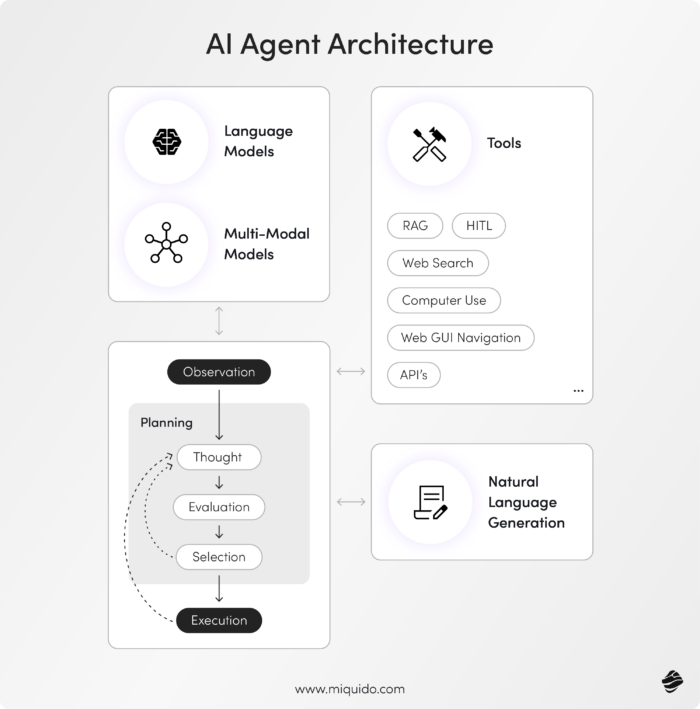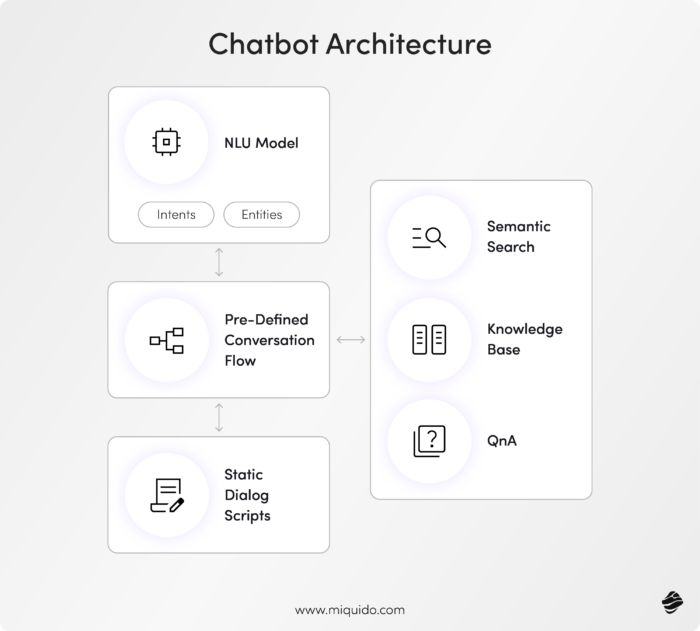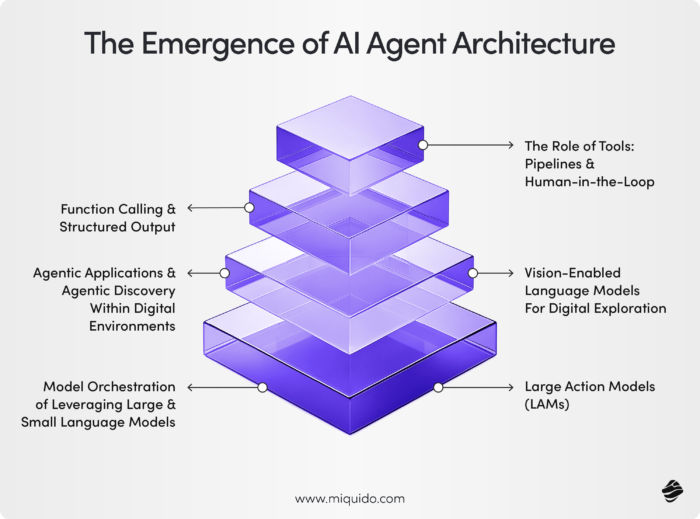

AI Agent Architecture Definition
What is AI Agent Architecture?
AI agent architecture defines the organizational structure and interaction of components within software agents or intelligent control systems. Also known as cognitive architecture in intelligent agents, it integrates sensors and actuators, enabling the agent to perceive its environment, reason about it, learn from it, and take actions accordingly. Agent systems enhance reasoning, planning, and tool calling, addressing critical issues such as bias, fairness, and the need for better benchmarks.
What’s exciting right now is that we’re seeing clear patterns and building blocks emerge for how these systems are being designed. These patterns are creating smarter, more capable AI agents that can make decisions, adapt to new situations, and perform tasks much more like humans. Companies like Apple, Microsoft, and researchers at Salesforce are leading the charge with new tools and technologies. Artificial intelligence encompasses various types of intelligent agents and their architectures, including symbolic, connectionist, and evolutionary approaches. Let’s break down the key ideas shaping the future of AI agent architecture.

What Are AI Agents?
At their core, AI agents are programs powered by Large Language Models—the same kind of technology behind tools like ChatGPT. These agents use LLMs to understand language, break down complex problems into smaller steps, and make decisions. The key components of AI agents include sensory input modules, beliefs, desires, intentions, and action modules, which work together harmoniously to enable them to understand their environment and perform tasks autonomously. They can also connect to external tools like APIs, databases, or other software to get things done.

An intelligent agent is a central element in building an AI system capable of perceiving its environment, setting goals, planning actions, making decisions, and learning from experiences.
For example:
- A simple AI agent might schedule a meeting after you ask it to check everyone’s calendars.
- A more advanced AI agent architecture could explore a website, find the best flight for your trip, and book it without you lifting a finger.
AI agents are moving beyond just responding to your requests—they’re learning to explore and interact with digital environments in creative ways.
What’s New in AI Agent Architecture?
Here’s what’s changing in the way we design AI agents:
Agentic AI architecture serves as a blueprint for creating AI systems that exhibit goal-directed behavior and adapt to their environment. Autonomous agents are AI systems that can operate independently, making decisions and adapting to their environment without human intervention.
1. Large Action Models (LAMs): Turning Ideas into Actions
AI isn’t just about language anymore—it’s about action. Large Action Models (LAMs) take what LLMs do (understanding and generating language) and add the ability to take meaningful actions.
For example, if you ask an agent to “schedule a meeting,” LAMs can break that down into steps, like:
- Generating parameters (e.g., time, participants).
- Calling an external tool (like a calendar API).
- Completing the task with structured results (e.g., “Your meeting is scheduled at 10 AM on Friday”).
This move toward structured outputs—where the AI gives you clear, actionable results rather than just text—is a game changer. Agents can now interact with external systems far more efficiently.

2. Combining Big Models and Small Models (Model Orchestration)
Instead of always relying on massive, resource-heavy Large Language Models, AI agents are starting to use Small Language Models for simpler tasks. This approach is called model orchestration, and it’s like having a team of specialized agents instead of one generalist doing everything.
For example:
- A large model might handle creative tasks, like writing a detailed email.
- A small model might summarize a document or process commands quickly.
To make smaller models smarter, developers use something called Retrieval-Augmented Generation. RAG gives small models access to knowledge libraries, so they can perform as well as larger models for certain tasks—without requiring tons of computing power. This balance saves time, money, and energy.
3. Vision Capabilities: Seeing and Exploring Digital Spaces
Many AI agents are being equipped with vision capabilities, meaning they can “see” and interact with visual environments. This is especially useful for agents that need to navigate websites, apps, or digital interfaces.
Natural language processing is essential for tasks involving complex interactions, pattern recognition, and the performance of AI agents in real-world scenarios.
For instance:
- Apple’s Ferret-UI lets an AI agent architecture identify buttons, forms, and text on a website, so it can click, type, and navigate like a human.
- An AI agent tasked with setting up an app in a new environment could read on-screen instructions, locate UI elements, and complete the setup autonomously.
This ability to combine language and vision makes AI agents much more versatile, especially in handling complex tasks in unfamiliar environments.
4. Function Calling: Making AI Outputs More Useful
One of the biggest shifts in AI agents is the ability to produce structured outputs instead of just unstructured text. In the past, you might ask an AI a question and get a written response. Now, with function calling, the AI can generate actionable outputs that trigger real-world actions.
For example:
- Instead of just saying, “Your flight is booked,” the AI can actually call a function to confirm the booking, update your calendar, and send you a receipt—all automatically.
- If the agent’s output is structured (e.g., in JSON format), it’s much easier for other systems to process and act on it.
This shift toward structured outputs is making AI agents far more effective at working with other software tools.
5. Tools and Human Support (Human-in-the-Loop)
AI agents aren’t just standalone systems—they use tools to extend their capabilities. Tools could be anything from APIs that fetch data to humans who step in for guidance when accuracy is critical.
For example:
- In healthcare or finance, a human might validate the agent’s decision before it’s finalized.
- In day-to-day tasks, an agent might rely on APIs to pull data from a database or perform calculations.
These tools act like pipelines, carrying information from one part of the system to another, transforming it along the way. They allow AI agents to work faster, smarter, and more accurately in complex environments.
Where Agents in AI Is Being Used
The advancements in AI agent architecture are unlocking all kinds of real-world applications, including:
- Digital Workflows: Automating administrative tasks like data entry, email follow-ups, or onboarding new software.
- Healthcare: Supporting diagnostics by analyzing images or patient data (with human oversight).
- Education: Creating adaptive learning tools that customize lessons for individual students.
- Creative Projects: Assisting with writing, graphic design, or video editing.
- Customer Support: Agents that can answer questions, book services, and resolve issues with minimal human intervention.
Multi-agent systems can dynamically adjust their strategies and facilitate complex decision-making processes. Additionally, multi-agent architectures offer significant advantages in complex problem-solving scenarios by enhancing the division of labor and adapting to specific tasks.
Why It Matters: The Future of AI Agent Architectures
AI agent architectures are no longer just tools that respond to commands—they’re evolving into intelligent systems that can think, act, and learn more like humans. Thanks to breakthroughs like Large Action Models, vision capabilities, model orchestration, and function calling, these agents are becoming smarter, faster, and more adaptable.
Autonomous AI systems can handle complex tasks across various domains, supported by sophisticated frameworks like Agentic AI Architecture. Single agent architectures are effective for well-defined tasks that do not require interaction with other agents. In the future, we’ll see AI agent architectures that seamlessly handle everything from managing your schedule to exploring digital environments and solving complex problems. With each advancement, AI agent architecture is moving closer to being trusted partners in work, creativity, and everyday life. The possibilities are endless, and the foundations being built today will shape how we interact with technology for years to come.
Ready to discover more terms?


